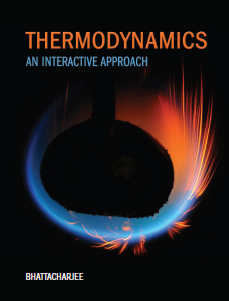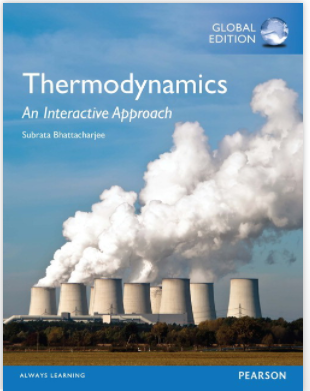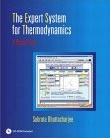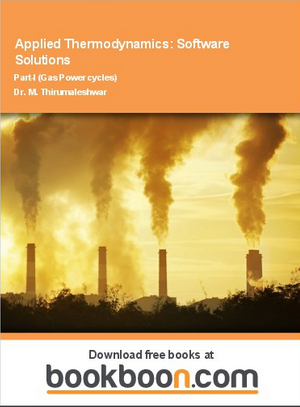Publications and Presentations Involving TEST
Thermodynamics: An Interactive Approach
Publication Date: 2015; Publisher: Pearson
Many years in the making, the book takes a different approach to learning Thermodynamics. The traditional spiral approach, where one topic leads to another, is replaced with a layered approach, where the whole picture is presented from the beginning and the mystery of thermodynamics is peeled off layer by layer. Entropy and exergy are introduced in the first chapter rather than treating them as some abstruse concepts traditionally delegated to later chapters. TEST is used as a numerical laboratory in the beginning, for verification of manual solutions, and pursuing what-if scenarios.

Thermodynamics: An Interactive Approach; Global Edition
Publication Date: 2016; Publisher: Pearson
Global edition of the same book.

BITES and TEST Web tools to Enhance Undergraduate Thermodynamics Course by Prof. Abhijit Nagchaudhuri, University of Maryland, Eastern Shore Paper ID #28706; ASEE Virtual Conference, June 20-26, 2020 E-mail address: anagchaudhuri@umes.edu
In the Thermodynamics course offered by the author at University of Maryland Eastern Shore for engineering undergraduates, two web-based tools -(i)BITES ( Buildings Industry Transportation and Electricity Generation Scenarios) developed at National Renewable Energy Laboratories (NREL) and (ii) TEST (The Expert System for Thermodynamics) developed at San Diego State University are introduced to the students and integrated with the course project and classroom instruction.
The BITES tool provides a framework to discuss thermodynamic cycles related to power, refrigeration, Otto, and Diesel cycles to energy production and utilization in commercial and residential buildings, as well as the transportation and industrial sector at large, and their relevance to carbon emission, ozone depletion, and climate change. The TEST tool is introduced to facilitate student comprehension of thermodynamic analyses of these cycles and the constituent processes. While students continue to struggle with solving problems related to thermodynamic cycles, practicing with the TEST software alleviates some of the difficulty with the progress of the course.
The ABET outcomes related to ethical and professional responsibilities and the impact of engineering solutions in global, economic, environmental, and societal contexts are strongly aligned to the course content. Relevance of Kigali and Paris accords, and the preceding Kyoto and Montreal protocols are also highlighted in the context of the course.
The paper will provide an overview of the course and the project work incorporating the web tools. Relevant student surveys and course assessments for the last two offerings of the course by the author will also be included.
A Review on Enhancing the Teaching and Learning of Thermodynamics by Profs. Normah Mulopa, Khairiyah Mohd, Yusofb , and Zaidatun Tasirc 2012 Published by Elsevier Ltd. Selection and/or peer-review under responsibility of Centre of Engineering Education, Universiti Teknologi Malaysia E-mail address: normahm.kl@utm.my
Thermodynamics is a subject that deals with energy and is one of the most advanced tools for understanding our physical universe. Engineering students’ difficulties in learning thermodynamics occur globally as indicated by the literature. There are various studies reporting on efforts made to overcome the deficiencies and suggestions of teaching approaches to enhance students learning such as blended learning approach, active learning techniques, computer-based instruction, virtual lab, a web-based student learning tool for thermodynamic concept related to multi-staging in compressors and turbines, TESTTM software in design projects and laboratory and so on. This paper presents a review and analysis of the different approaches on supporting students learning of thermodynamics. The criteria for analysis are the characteristics of the learning system, the effectiveness based on students’ performance; the skill developed using the learning system, and students’ feedback.
The Expert System For Thermodynamics - A Visual Intro
Published by Prentice Hall in 2002, the book introduces TEST 6.5 (www.thermofluids.net) visually through a series of screenshots organized into ten different chapters. Covering examples from simple state evaluation through air conditioning, this visual manual reveals the power of TEST and walks the users, experts and novices alike, through effective problem solving. It is available from amazon.com and complements the online Tutorial.
Note that the CD in the book has already expired and a newer version must be ordered through the myAccount page at www.thermofluids.net.

Applied Thermodynamics: Software Solutions by Dr. M. Thirumaleshwar, 2014
Published by bookboon.com, this series of e-books by Dr. M. Thirumaleshwar compares different thermodynamic software including TEST to solve thermal system problems. This is a logical continuation from the book âBasic Thermodynamics: Software Solutionsâ, published earlier. In this book, problems on âGas power cyclesâ are solved. Cycles dealt with are: Carnot cycle, Otto cycle (for petrol engines), Diesel and Dual combustion cycles (for Diesel engines) and Stirling cycle. Software used are: Mathcad, Engineering Equation Solver (EES), and The Expert System on Thermodynamics (TEST). An introduction to these softwares is given in Part-I of the free eBook âBasic Thermodynamics: Software Solutionsâ, published in five parts, which can be downloaded for free from www.bookboon.com.
The books are accessible from here .
A Cyber-based Collaborative Framework for Thermodynamic Education and Research by Prof. S. Bhattacharjee (NSF Cyber Infrastructure Workshop on Combustion, NSF, April 19-20, 2006)
For last ten years, we have been building a comprehensive webware TEST ÃÂ The Expert System for Thermodynamics, accessible from www.thermofluids.net - for thermodynamic education and practice. TEST is a visual platform where a user can look up traditional charts and tables, visualize thermodynamic systems through animations and interactive dynamic images, browse thermodynamic problems and solutions enriched with multimedia, and employ web-based thermodynamic calculators called daemons to solve most traditional thermodynamic problems on topics ranging from energy, entropy and exergy analysis of generic systems to analysis of airconditioning or combustion applications. Once a visual solution is obtained, the solution can be used as a baseline case for a myriad of parametric studies or what-if scenarios. Created with web friendly tools, TEST is platform independent, can be locally installed for speed, and is completely browser based. A TEST solution - although visual in nature - can be saved, recreated instantly, or shared through email for remote collaboration.
In this presentation, we will demonstrate some of the features of TEST through its combustion and chemical equilibrium daemons. Using this as the basis, we will introduce our future plan that can be quite relevant to the combustion community. We would like to develop the existing webware into a community based suite of tools that can be enriched by users, allowing them the ability to prototype new chemical structures and upload thermochemical specifications to a shared, Internet accessible database. New species would be tagged as experimental and then be assigned different confidence levels after passing a peer-reviewed vetting process. New species added to the database are made immediately available to all researchers in real-time for use in constructing reactant mixture compositions or in the specification of product compositions when performing an equilibrium analysis. The initial database will be populated with thermochemical data adopted from the NIST WebBook ( http://webbook.nist.gov/). Our solvers will run Java Web Service (WS) and will be made available to the Internet grid computing community. Developers of distributed and grid enabled combustion applications will be free to invoke the resources of our chemical equilibrium web service on demand. Communication to and from our web service is encapsulated in an XML framework. Each equilibrium problem will be specified in XML and passed by the developer's client application to our web service for computation. The solution will then be calculated by our web service and passed back to the client as an XML message encapsulating the moles or masses of each product species. Our web service will run in a standard open source servlet container such as Apache Tomcat ( http://tomcat.apache.org/) and be implemented using a standard open source SOAP engine such as Apache Axis ( http://ws.apache.org/axis/). We envision our implementation of a chemical equilibrium web service will amount to a plug-and-play computational software environment, freely available to developers of cyber-based combustion applications. Researchers and educators would be able to outsource most of their equilibrium computational needs to this web-based service and couple these remote procedure calls in their existing or future computational codes.
TEST - The Expert System for Thermodynamics by Prof. S. Bhattacharjee (Proceedings of the 2003 American Society for Engineering Education Annual Conference & Exposition Copyright é 2003, ASEE)
Just as calculators revolutionized engineering problem solving, the day has come for web-delivered domain-specific software tools to bring about the next revolution in engineering education and practice. Students can not only solve a problem online, but conduct parametric studies, simulate engineering systems and gain an insight which is not possible in a traditional set up. Web delivery means the software is available anywhere, anytime from classroom to the dormitory without the hassles of installation, upgrades, or compatibility with operating systems. Such a web-based tool, TEST, The Expert System for Thermodynamics, is being developed at San Diego State University for a comprehensive education of engineering thermodynamics. TEST is more than a thermodynamic calculator. It combines hundreds of HTML pages with the power of Java programming to offer a visual environment over the web to analyze thermodynamic problems, obtain paperless solution, plot thermodynamics graphs, generate solutions and reports, spreadsheet friendly thermodynamic tables, pursue what-if scenarios after a problem is solved, and produce TEST-Code which can be stored or emailed to regenerate a solution instantly. The topics covered include state evaluation, energy, entropy and exergy analysis, closed and open cycles, refrigeration, air-conditioning, combustion and gas dynamics.
Engineering systems are introduced through animations and classified according to how the governing equations simplify - open vs. closed systems, for instance. Once a system is classified, choosing an appropriate model for the working fluid - ideal gas, real gas, phase-change model, etc. - launches a Java Applet, called a daemon in TEST, which has the knowledge of the working fluid properties as well as the simplified form of the mass, energy, entropy, and exergy equations for the particular system. The expert system not only helps one solve a problem fast and accurately but also helps detect logical inconsistencies in the specifications of the input variables. If pressure and temperature are entered for an ideal gas, the daemon will prevent a user (with appropriate warning) from specifying the gas density. But the main advantage of the visual environment is the ease with which parametric studies can be performed. Because all the variables of a problem are visually exposed, any conceivable what-if scenario can be pursued with the click of a button without a single line of programming.
Learning enhancement in Thermodynamics Classroom via use of TEST software in design projects and laboratory by Prof. Subha K. Kumpaty (Proceedings of the 2002 American Society for Engineering Education Annual Conference & Exposition Copyright é 2002, ASEE)
Introduced in Spring 1999 into the MSOEÃÂs three-quarter Thermodynamics sequence, The Expert System for Thermodynamics (TESTÃÂ software by Subrata Bhattacharjee)1 has become a great asset and an excellent tool in enhancing studentsÃÂ learning of Thermodynamics fundamentals. The presenter, Dr. Kumpaty encouraged the institution-wide use of the software by obtaining a site license and has personally tested its use in classroom, design projects and laboratory for the last three years. All mechanical engineering (ME) and mechanical engineering technology (MET) students run a 100-kW steam power plant in the laboratory at various part- loads and full load in groups of 10 and conduct thorough, first and second law analyses on the plant employing the user-friendly software. They are also assigned 3 to 4 design projects in the Thermodynamics sequence, the treatment of which has become easier with the parametric studies accommodated superbly by the TESTÃÂ software. The overall experience with this integrated teaching has been very rewarding to both faculty and students. The details of the experience, a sample problem, a sample project, laboratory activities and the effective utilization of the software/courseware are presented.
Internet-based expert systems by R. Grove (Expert Systems, Vol. 17, No. 3, pp. 129-135 2000)
TEST is identified in this paper as one of the three expert system portals used in education and research.
First-principles calculations for VxOy grown on Pd(1 1 1) by Kresse, G., Surnev, S., Ramsey, M.G., and Netzer, F.P., by Ridwar, M., Yap, C., and Mannan, M.A. (Surface Science Vol. 492, pp. 329-344, 2001)
TEST is used for thermodynamic property calculations in this work.
INTERACTIVE DEMONSTRATIONS OF STATISTICAL QUALITY CONTROL FOR ENGINEERING STUDENTS USING COMPUTER BASED TOOLS by Aichoouni, M., and Al-Nais, M.O, (The Third Forum on Engineering Education, UAE, 2003)
TEST is referred as one of the prominent web-based educational packages.
WEB-BASED APPROACH APPLIED TO TECHNICAL COURSES TO ENHANCE ENGINEERING EDUCATION QUALITY by Al-Nais, M.O, and Aichoouni, M., (Proceedings of the 1st Baha Technical Meeting, Vol 2, pp 131- 137, Baha College of Technology, May, 3-5 ,2004)
TEST is referred as one of the prominent web-based educational packages.
Report and Recommendation on Available Multimedia Material for Statistical and Thermal Physics by Benedict, M., Debowska, E., Jodl, H.J., Mathelitsch, L., Sporken, R., Bradfield, T., Colbert, T., Mason, B., Melder, T., Sen, S., Sheldon, P., and Rauber, J., (Proc. of the 10th Workshop on Multimedia in Physics Teaching and Learning (EPS - MPTL 10), Berlin, 2005)
The paper recommends TEST as the only coursware i nthe Excellent Materials category after a review of all existing electronic resources.
A Web Service Infrastructure for Thermodynamic Data by Paolini, C., and Bhattacharjee, S., (J. of Chem. Info Modeling, Vol 48, 1511-1523, 2008.)
W3C standardized Web Services are becoming an increasingly popular middleware technology used to facilitate the open exchange of chemical data. While several projects in existence use Web Services to wrap existing commercial and open-source tools that mine chemical structure data, no Web Service infrastructure has yet been developed to compute thermochemical properties of substances. This work presents an infrastructure of Web Services for thermochemical data retrieval. Several examples are presented to demonstrate how our Web Services can be called from Java, through JavaScript using an AJAX methodology, and within commonly used commercial applications such as Microsoft Excel and MATLAB for use in computational work. We illustrate how a JANAF table, widely used by chemists and engineers, can be quickly reproduced through our Web Service infrastructure.
The Chemical Thermodynamic Module of The Expert System for Thermodynamics (âÂÂTESTâÂÂ) Web Application by Bhattacharjee, S., and Paolini, C., (Proceedings of the 2003 American Society for Engineering Education Annual Conference & Exposition Copyright ÃÂé 2009, ASEE)
Accessible from www.thermofluids.net, the TEST web portal is a freely accessible thermodynamics web-based software package for engineering education. It combines several modules â multi-media problems and examples, an online solution manual for educators, traditional thermodynamic charts and tables, fifteen chapters of animations to illustrate thermodynamic systems and fundamental concepts, and a suite of thermodynamic calculators called daemons for solving thermodynamic problems and pursuing what-if scenarios. Designed as âÂÂbrowsableâ Java applets, these daemons cover a wide range of topics - property evaluation of working substances, energy, entropy, and exergy analysis of generic open and closed systems, IC engines, gas and vapor power cycles, refrigeration, HVAC, combustion, chemical equilibrium, and gas dynamics. In this paper, the chemistry module comprising of combustion and equilibrium analysis daemons for both open steady systems and unsteady processes is presented. The combustion daemons can be used for the analysis of both premixed and non-premixed reactants modeled with a perfect gas, ideal gas, or a solid/liquid model. Using the intuitive graphical user interface of the reaction panel, a user can quickly set up standard reactions such as theoretical reactions, reactions with a known amount of excess or deficient air, and reactions with known dry products analysis. The balanced equations are then used in the state panel and the states of fuel, oxidizer, and products are fully or partially calculated based on the known properties at the ports of a steady state reactor or at the beginning and final states of a process. Finally, in the device (or process) panel, known information about the device (or process) is supplied and the daemon updates the entire analysis to produce important combustion parameters such as the adiabatic flame temperature, heat transfer, and entropy generation in the device or the process. Once a solution is achieved, what-if studies can be performed by changing the fuel, the air fuel ratio, or any other controllable parameter by simply changing the parameter and calculating a single update button. The equilibrium daemons handle gas mixtures and condensed phases and builds upon the combustion daemons. Reactants are entered by selecting from a list of species and specifying their moles. From a list of plausible products, the user can select product species. In the state panel, known thermodynamic properties such as pressure and temperature are specified. The products composition is then calculated by minimizing the Gibbs function of the products mixture. These simple-to-use daemons, comparable in their accuracy to established codes such as NASA CEA1 and STANJAN2, are used to determine equilibrium constant, equilibrium composition, and equilibrium temperature of methane combustion as a function of equivalent ratio.
Property evaluation in The Expert System for Thermodynamics (TEST) web application by Bhattacharjee, S., and Paolini, C., (Calphad Volume 33, Issue 2, June 2009, Pages 343âÂÂ352 Tools for Computational Thermodynamics)
Ever since its release, TEST has found use as thermodynamic courseware in many universities around the world. TEST offers web-based analysis toolsâÂÂjava applets called daemonsâÂÂfor property evaluation of working substances, energy, entropy, and exergy analysis of generic open and closed systems, IC engines, gas and vapor power cycles, refrigeration, HVAC, combustion, chemical equilibrium, and gas dynamics. Other modules of TEST include animations, problems, examples, and system navigations that are closely integrated with the daemon module to create a comprehensive analysis tool for engineering thermodynamics. In this paper the methodology of thermodynamic state evaluation by TEST is discussed with several examples.
DESIGN OF A RICH INTERNET APPLICATION FOR GAS TURBINE ENGINE SIMULATIONS by Crosby Johnson, Christopher Paolini, and Subrata Bhattacharjee (Proceedings of ASME Turbo Expo 2011 GT2011 June 6-10, 2011, Vancouver, Canada)
Modeling the performance and emissions characteristics of gas turbine engines can involve sequentially solving multiple thermodynamic states of a representative fluid flowing through the engine, evaluating cycle performance, and evaluating the chemical equilibrium of the fluid at select states. The states are defined by the combination of specified thermodynamic conditions, process assumptions derived from established theory of gas turbine engines, and thermodynamic properties of the representative fluid. Internet based applications such as TEST allow experienced analysts to structure and evaluate thermodynamic models of gas turbine engines and separately evaluate the chemical equilibrium of air-fuel mixtures to predict exhaust emissions. Although the TEST thermodynamic and chemical equilibrium data retrieval is automated, analysts are required to first structure the system model. The Internet based software described in this paper allows analysts to combine the modeling of performance and emissions characteristics of gas turbine engines without the need to first structure a model, broadening the range of potential analysts beyond the thermodynamic and chemical equilibrium communities. The software presented in this work combines a visually rich and Internet based interface to input specifications and display results, a communication mechanism to obtain Internet based thermodynamic and chemical equilibrium data, and a solution architecture to autonomously interpret user inputs and Web based data and model engine parameters. This software also allows analysts to modify the model complexity, accounting for irreversibilities and auxiliary devices such as regenerators, reheaters, and intercoolers as required. Data reduction features such as graphical representation of parametric studies and combustion product distribution are also available within the software.
IGE Model: An Extension of the Ideal Gas Model to Include Chemical Composition as Part of the Equilibrium State by Paolini, C., and Bhattacharjee, S., (Journal of Thermodynamics Volume 2012 (2012), Article ID 870631, 18 pages doi:10.1155/2012/870631)
The ideal gas (IG) model is probably the most well-known gas models in engineering thermodynamics. In this paper, we extend the IG model into an ideal gas equilibrium (IGE model) mixture model by incorporating chemical equilibrium calculations as part of the state evaluation. Through a simple graphical interface, users can set the atomic composition of a gas mixture. We have integrated this model into a thermodynamic web portal TEST (http://thermofluids.sdsu.edu/) that contains Java applets for various models for properties of pure substances. In the state panel of the IGE model, the known thermodynamic properties are entered. For a given pressure and temperature, the mixture's Gibbs function is minimized subject to atomic constraints and the equilibrium composition along with thermodynamic properties of the mixture are calculated and displayed. What is unique about this approach is that equilibrium computations are performed in the background, without requiring any major change in the familiar user interface used in other state daemons. Properties calculated by this equilibrium state daemon are compared with results from other established applications such as NASA CEA and STANJAN. Also, two different algorithms, an iterative approach and a direct approach based on minimizing different thermodynamic functions in different situation, are compared.
TEST: The Expert System for Thermodynamics: A web-portal to Make Thermodynamics Fun to Learn and Practice, 36th National Convention of Mechanical Engineers and National Conference on Innovations in Thermal Science and Engineering Innovations in Thermal Science and Engineering; State of the art Lecture Series; Organized by Institute of Engineers (India), Dec 5-6, 2021
An overview of the TEST portal, www.thermofluids.net, is presented in this talk.